Blog
Swirl

Introduction
What are swirls?
Swirls, also known as vortex patterns or spirals, are characterized by their twisting and spiraling shapes. They can be found in various forms, ranging from subtle natural phenomena to elaborate artistic designs.
Importance of swirls in various contexts
Swirls hold significance in numerous fields, including art, science, culture, and psychology. Their mesmerizing allure has intrigued humanity for centuries, leading to their widespread integration into different aspects of human life.
2. Natural Occurrences of Swirls
Swirls in nature
Natural phenomena such as ocean currents, cloud formations, and galaxies exhibit swirling patterns. These occurrences result from complex interactions of forces and elements in the environment, showcasing the beauty and power of nature’s design.
Examples from different environments
Examples of natural swirls abound, with each showcasing the elegance and dynamism of swirling patterns. From the graceful movements of underwater eddies to the majestic spirals of distant galaxies, nature’s canvas is adorned with swirls of varying scales and intricacies.
3. Artificial Swirls: Creation and Design
How are artificial swirls created?
Artificial swirls are often crafted using various techniques, including painting, digital design, and sculpture. Artists and designers employ different tools and mediums to bring their swirl visions to life, resulting in stunning visual compositions.
Design considerations for creating swirl patterns
In the realm of design, factors such as symmetry, color harmony, and spatial arrangement play crucial roles in shaping swirl patterns. Attention to detail and artistic intuition guide the creation process, ensuring the aesthetic appeal and coherence of the final artwork.
4. Swirls in Art and Design
Historical significance of swirls in art
Swirl motifs have a rich history in art, spanning across diverse cultures and periods. From ancient cave paintings to Renaissance masterpieces, artists have incorporated swirls into their works to convey movement, energy, and emotion.
Modern applications of swirls in design
In contemporary design practices, swirls continue to inspire creativity and innovation. From graphic design and fashion to product packaging and interior décor, swirl patterns add a touch of elegance and dynamism to various design projects.
5. Symbolism and Cultural Significance of Swirls
Interpretations of swirls in different cultures
Swirls hold symbolic meanings in different cultures and traditions. In some societies, they represent unity, infinity, and interconnectedness, while in others, they symbolize transformation, growth, and spiritual enlightenment.
Symbolic meanings associated with swirl patterns
The interpretation of swirl patterns varies across cultures, with each imbuing these motifs with unique significance. Whether as symbols of cosmic harmony or as representations of inner consciousness, swirls evoke profound meanings and interpretations in diverse cultural contexts.
6. Psychological Impact of Swirls
Effects of swirl patterns on human perception and emotion
Swirl patterns have been studied for their psychological effects on human cognition and emotion. Research suggests that exposure to swirl imagery can evoke feelings of tranquility, fascination, and introspection, influencing mood and mental state.
Utilization of swirls in psychological studies and therapies
In therapeutic contexts, swirl patterns are utilized to promote relaxation, mindfulness, and stress reduction. Techniques such as mandala coloring and visual meditation leverage the calming properties of swirls to enhance psychological well-being and self-awareness.
7. Swirls in Science and Technology
Applications of swirl patterns in various scientific fields
Swirl patterns find applications in diverse scientific disciplines, including fluid dynamics, astronomy, and materials science. Their intricate geometries and dynamic behaviors offer valuable insights into complex phenomena and processes.
Technological innovations inspired by swirl phenomena
Innovations in technology often draw inspiration from natural swirl phenomena. Biomimetic design principles, inspired by the efficiency and elegance of swirl patterns in nature, drive advancements in fields such as aerodynamics, robotics, and renewable energy.
8. Swirls in Pop Culture and Media
Representation of swirls in movies, music, and literature
Swirl motifs frequently appear in popular culture, enriching storytelling and visual aesthetics across various media. From cinematic special effects to album cover artwork, swirls contribute to the immersive experience of entertainment and artistic expression.
Popularity of swirl-themed merchandise and fashion
Swirl patterns have become popular motifs in fashion and merchandise design, adorning clothing, accessories, and home décor items. Their timeless appeal and versatile aesthetics make them sought-after elements in the world of consumer goods and fashion trends.
9. Health and Wellness: Swirls and Meditation
Incorporating swirl imagery in meditation practices
Swirl patterns are often utilized as focal points in meditation and mindfulness exercises. Their repetitive and rhythmic nature facilitates concentration and relaxation, enabling practitioners to achieve a state of inner calm and mental clarity.
Benefits of focusing on swirl patterns for relaxation and mindfulness
By directing attention to swirl imagery, individuals can alleviate stress, anxiety, and mental fatigue, promoting overall well-being and emotional balance. The therapeutic effects of swirl-focused meditation techniques contribute to improved mental health and resilience.
10. Swirls in Cuisine and Gastronomy
Culinary uses of swirl designs in food presentation
Swirl patterns are not limited to visual arts but also find expression in culinary creations. Chefs and food artists incorporate swirl designs into dishes and desserts, enhancing their visual appeal and culinary experience for diners.
Creative applications of swirls in culinary arts
From intricate sauce swirls to delicate pastry decorations, swirl motifs add an artistic flair to culinary presentations. Creative experimentation with swirl patterns opens up possibilities for culinary innovation and gastronomic delight.
11. Environmental Impacts of Swirls
Effects of swirl patterns on ecosystems and natural habitats
In natural environments, swirl patterns play essential roles in shaping ecological processes and habitats. From ocean currents that distribute nutrients to air currents that disperse seeds, swirl phenomena influence the dynamics of ecosystems worldwide.
Conservation efforts related to preserving swirl-rich environments
Conservation initiatives recognize the ecological significance of swirl-rich environments and seek to protect them from human disturbances and environmental degradation. By safeguarding natural habitats and promoting sustainable practices, conservationists aim to preserve swirl ecosystems for future generations.
12. Swirls in Fashion and Textiles
Fashion trends featuring swirl motifs
Swirl patterns often make appearances in fashion collections, reflecting designers’ fascination with fluid forms and dynamic movements. From swirling prints on garments to swirling motifs in accessories, fashionistas embrace swirls as symbols of elegance and sophistication.
Textile designs incorporating swirl patterns
Textile designers experiment with swirl patterns to create captivating fabric designs for apparel, upholstery, and home textiles. The interplay of colors, textures, and shapes in swirl motifs adds depth and visual interest to textile surfaces, enriching the tactile and aesthetic experience for consumers.
13. Swirls in Architecture and Interior Design
Architectural elements inspired by swirls
Architects draw inspiration from swirl patterns to incorporate dynamic and fluid forms into building designs. From swirling staircases to curvilinear facades, architectural swirls transform spaces, evoking a sense of movement and energy.
Interior design concepts utilizing swirl patterns
In interior design, swirl motifs are used to embellish walls, floors, and furnishings, infusing spaces with visual intrigue and artistic expression. Whether as subtle accents or bold statements, swirl patterns enhance the ambiance and character of interior environments.
14. Educational Value of Swirls
Teaching aids using swirl illustrations
Educators leverage swirl imagery as teaching aids to engage students and illustrate abstract concepts in various subjects. Visual representations of swirl patterns facilitate learning and comprehension, making complex topics more accessible and engaging for learners of all ages.
Incorporating swirls in educational activities for children
In educational settings, swirl-themed activities encourage creativity, exploration, and critical thinking skills in children. Art projects, science experiments, and math activities inspired by swirl patterns foster interdisciplinary learning and imaginative play.
15. Conclusion
Swirl patterns embody a mesmerizing blend of beauty, complexity, and symbolism that transcends boundaries and disciplines. From their origins in natural phenomena to their diverse applications in art, science, and culture, swirls continue to captivate our imagination and inspire creativity in myriad ways. As we navigate the swirling currents of life, may we find inspiration and wonder in the intricate patterns that surround us.
FAQs
What is the significance of swirl patterns in art and design?
Swirl patterns are valued for their aesthetic appeal and symbolic meanings in art and design. They evoke a sense of movement, rhythm, and energy, enriching visual compositions and conveying diverse emotions and concepts.
How are swirl patterns utilized in therapeutic practices?
Swirl patterns are utilized in therapeutic practices such as mindfulness meditation and art therapy to promote relaxation, stress reduction, and emotional healing. Focusing on swirl imagery facilitates concentration and introspection, fostering a sense of calm and well-being.
What are some examples of swirl motifs in popular culture?
Swirl motifs frequently appear in popular culture, including movies, music videos, and literature. Examples include swirling special effects in fantasy films, psychedelic album cover artwork, and swirling motifs in literary symbolism.
How do swirl patterns influence consumer behavior in fashion and design?
Swirl patterns often evoke positive associations with creativity, dynamism, and sophistication, influencing consumer preferences and purchasing decisions. Fashion and design brands leverage swirl motifs to enhance product appeal and differentiate their offerings in the market.
What are the environmental implications of swirl phenomena?
Swirl phenomena play vital roles in shaping environmental processes and ecosystems, including ocean currents, atmospheric circulation, and sediment transport. Understanding the dynamics of swirl patterns is essential for mitigating environmental impacts and conserving natural habitats.
Blog
Finley Aaron Love Lockwood: The Life and Legacy of Elvis Presley’s Granddaughter

Introduction
Finley Aaron Love Lockwood is a name that resonates with legacy and history. As the granddaughter of the legendary Elvis Presley, she carries a significant heritage that has shaped her life from the very beginning. This article delves into the fascinating story of Finley Aaron Love Lockwood, exploring her family background, early life, and the impact of her famous lineage.
Family Background
Finley is a descendant of the iconic Presley family, a name synonymous with rock and roll and cultural impact. Her grandfather, Elvis Presley, known as the King of Rock and Roll, left an indelible mark on the music industry and popular culture. Her mother, Lisa Marie Presley, continued the family’s musical tradition while also navigating the complexities of fame.
Early Life
Born on October 7, 2008, Finley Aaron Love Lockwood entered the world alongside her twin sister, Harper Vivienne Ann Lockwood. The twins were born to Lisa Marie Presley and her then-husband, Michael Lockwood. From their early years, Finley and Harper have been in the spotlight, garnering public interest due to their famous heritage.
The Presley Legacy
Elvis Presley’s influence extends beyond his music, shaping the lives of his descendants. For Finley, being a Presley means living up to a name that carries immense cultural weight. The Presley legacy is a double-edged sword, offering opportunities but also posing significant expectations.
Parents: Lisa Marie Presley and Michael Lockwood
Lisa Marie Presley, Finley’s mother, has had a multifaceted career as a singer-songwriter. Her personal life, including her relationships and struggles, has often been in the public eye. Michael Lockwood, Finley’s father, is a musician and producer. Together, they have provided a nurturing yet high-profile environment for Finley and her sister.
Grandmother: Priscilla Presley
Priscilla Presley, Finley’s grandmother, has been a guiding force in the family. Known for her own contributions to entertainment and philanthropy, Priscilla has played a significant role in Finley’s upbringing. Her influence helps bridge the generational gap, keeping Elvis’s memory alive while supporting her grandchildren.
Public Appearances
Finley and her twin sister made their first public appearances at a young age. Their presence at various family and public events has always attracted media attention. Despite the intense public scrutiny, the family strives to maintain a sense of normalcy for the twins.
Family Dynamics
Family is at the core of Finley’s life. Her relationship with her mother, Lisa Marie, is pivotal, with Lisa Marie’s experiences in the public eye providing valuable lessons. Finley’s bond with her twin sister, Harper, is equally strong, offering mutual support in their unique journey. The influence of her father, Michael Lockwood, adds another layer to her upbringing, blending musical talent and parental guidance.
Education and Hobbies
Finley’s education is a priority for the family, ensuring she has a well-rounded upbringing. Besides academics, she engages in various hobbies and extracurricular activities, which help her develop her interests and talents. Whether it’s music, sports, or arts, Finley’s activities are diverse, reflecting her multifaceted personality.
Challenges and Triumphs
Living up to the Presley name is no small feat. Finley faces the challenge of balancing her personal identity with the public’s expectations. However, she also enjoys the unique opportunities that come with her heritage. Triumphs in her young life include finding her own passions and navigating the complexities of fame with grace.
Media Attention
The media’s fascination with the Presley family extends to Finley. Stories and images of her often appear in tabloids and online platforms. While this attention can be overwhelming, it also highlights the enduring interest in Elvis Presley’s descendants. The family’s approach to media scrutiny is to provide as much normalcy and privacy as possible.
Social Media Presence
In today’s digital age, social media presence is almost inevitable. However, the Lockwood family is cautious about Finley’s online exposure. They prioritize her privacy and ensure that any online presence is carefully managed. This approach helps protect Finley from the potential pitfalls of social media fame.
Future Prospects
As Finley grows, speculation about her future increases. Will she follow in her grandfather’s musical footsteps, or carve out a unique path of her own? Whatever her choice, the legacy she inherits provides a strong foundation. The possibilities are endless, and the world watches with keen interest.
Conclusion
Finley Aaron Love Lockwood’s life is a blend of heritage, fame, and potential. As the granddaughter of Elvis Presley, she carries a name that opens doors while also presenting challenges. Her journey is one of navigating public attention, embracing her legacy, and forging her path. Finley’s story is still unfolding, and it promises to be as captivating as the Presley legacy itself.
Danielzinho: A Rising Star in the World of Football
FAQs
Who are Finley Aaron Love Lockwood’s parents?
Finley’s parents are Lisa Marie Presley, the daughter of Elvis Presley, and Michael Lockwood, a musician and producer.
What is Finley’s relationship with the Presley family?
Finley is closely related to the Presley family, being the granddaughter of Elvis Presley and Priscilla Presley. She has a strong bond with her mother, Lisa Marie Presley, and her twin sister, Harper.
How does Finley handle public attention?
Finley handles public attention with the support of her family, who prioritize privacy and normalcy. Despite the media interest, they strive to maintain a balanced and private upbringing.
Does Finley have a social media presence?
The Lockwood family is cautious about Finley’s social media presence, ensuring her privacy is protected. Any online presence is carefully managed to avoid the pitfalls of social media fame.
What are Finley’s future plans?
While Finley’s future is still unfolding, there is speculation about her potential career paths. Whether she chooses to follow in the Presley musical legacy or carve out her unique path, her heritage provides a strong foundation for success
Blog
SSIS 816: A Comprehensive Guide to SQL Server Integration Services

Introduction
Welcome to the ultimate guide on SSIS 816! If you’re delving into the world of data integration and management, understanding SQL Server Integration Services (SSIS) is crucial. SSIS 816 stands out as a robust tool for handling complex data transformation and migration tasks. But what exactly is SSIS 816, and why is it so important?
What is SSIS 816?
SSIS 816 is the latest version of Microsoft’s SQL Server Integration Services, a platform for building enterprise-level data integration and data transformations solutions. SSIS 816 offers enhanced features and improvements that streamline data management, making it a go-to for businesses looking to optimize their data processes.
Importance of SSIS in Data Integration
Data integration is vital for businesses to consolidate data from various sources, ensuring that they have a unified and accurate dataset. SSIS simplifies this process by providing powerful tools to extract, transform, and load (ETL) data across different databases and systems.
Understanding SSIS 816
SSIS 816 brings several new features and enhancements that differentiate it from its predecessors. These include improved performance, more extensive connectivity options, and enhanced scripting capabilities.
Features of SSIS 816
Some of the standout features include:
- Enhanced Data Flow Components: More efficient data processing capabilities.
- Advanced Scripting Options: Customizable scripting for tailored solutions.
- Better Integration with Azure: Streamlined cloud operations and hybrid scenarios.
Comparison with Previous Versions
Compared to earlier versions, SSIS 816 provides a more intuitive interface, faster processing speeds, and improved error handling mechanisms. These enhancements make it easier for users to create and manage ETL packages.
Installing SSIS 816
System Requirements
Before diving into installation, ensure your system meets the necessary requirements:
- Operating System: Windows Server 2016 or later
- Processor: 1.4 GHz or faster
- RAM: Minimum 4 GB (8 GB recommended)
- Disk Space: At least 2 GB of available space
Step-by-Step Installation Guide
- Download the Installer: Get the latest version from the Microsoft website.
- Run the Installer: Follow the prompts to install SSIS 816.
- Configure the Installation: Choose the components you need.
- Complete the Installation: Finish and verify the setup.
Core Components of SSIS 816
Understanding the core components of SSIS 816 is essential for creating effective ETL solutions.
Control Flow
Control Flow manages the workflow of your SSIS package, controlling the execution order of tasks.
Data Flow
Data Flow is where the actual data transformation happens, allowing you to manipulate and move data between sources and destinations.
Event Handlers
Event Handlers provide a way to manage actions triggered by package events, such as errors or completion.
Package Explorer
Package Explorer offers a tree view of all components in your package, facilitating easy navigation and management.
Creating Your First SSIS Package
Creating an SSIS package involves several steps:
Setting Up a New Project
- Open SQL Server Data Tools (SSDT): Create a new SSIS project.
- Define the Package: Name your package and set its properties.
Designing a Basic Data Flow
- Add Data Flow Task: Drag it onto the Control Flow canvas.
- Configure Data Sources and Destinations: Specify where data is coming from and where it’s going.
- Add Transformations: Include any necessary data transformation tasks.
Executing the Package
Run your package to ensure it functions correctly. Check for errors and verify the data has moved as expected.
Advanced SSIS 816 Features
SSIS 816 offers advanced features for more complex ETL scenarios:
Data Transformation Tasks
Use tasks like Lookup, Merge Join, and Aggregate to manipulate data efficiently.
Scripting and Customization
Script tasks and components allow for custom code to handle unique data processing needs.
Error Handling and Logging
Implement robust error handling and logging to monitor package execution and diagnose issues.
Data Sources and Destinations
SSIS 816 supports a wide variety of data sources and destinations, making it a versatile tool for data integration.
Connecting to Various Data Sources
Connect to databases like SQL Server, Oracle, and MySQL, as well as flat files, Excel, and web services.
Configuring Data Destinations
Specify where transformed data will be stored, whether it’s a database, a file, or another system.
Performance Tuning in SSIS 816
Optimizing the performance of your SSIS packages is crucial for handling large datasets efficiently.
Optimizing Data Flow
Use techniques like blocking transformations sparingly and optimizing buffer size settings.
Using Parallel Execution
Leverage parallel execution to speed up data processing tasks.
Managing Resources Efficiently
Monitor resource usage and adjust package configurations to balance performance and resource consumption.
SSIS 816 Security
Security is paramount in data integration. SSIS 816 provides several mechanisms to ensure data security.
Implementing Package Protection Levels
Choose appropriate protection levels to secure sensitive data within your packages.
Secure Data Transfer
Encrypt data transfers to protect against unauthorized access.
User Roles and Permissions
Define roles and permissions to control access to SSIS packages and components.
Integration with Other Microsoft Tools
SSIS 816 integrates seamlessly with other Microsoft tools, enhancing its functionality.
SSIS and SQL Server
Use SSIS for SQL Server to streamline data management tasks within your SQL environment.
SSIS and Azure
Integrate with Azure for cloud-based data processing and storage solutions.
SSIS and Power BI
Feed data into Power BI for advanced analytics and reporting.
SSIS 816 Deployment
Deploying SSIS packages requires careful planning and execution.
Preparing for Deployment
Ensure your packages are thoroughly tested and optimized before deployment.
Deploying Packages
Use the SSIS catalog and deployment wizard to deploy packages to your target environment.
Monitoring and Managing Deployed Packages
Monitor package execution and performance using SQL Server Management Studio (SSMS).
SSIS 816 in Real-World Applications
SSIS 816 is used in various industries to solve complex data integration challenges.
Case Studies
Explore real-world examples of SSIS in action, such as data migration projects and ETL processes in large enterprises.
Best Practices
Follow best practices for designing, deploying, and maintaining SSIS packages to ensure reliability and performance.
Troubleshooting SSIS 816
Despite its robustness, you may encounter issues with SSIS 816. Here’s how to handle common problems.
Common Issues and Solutions
Address issues like data truncation, connection failures, and performance bottlenecks.
Debugging Techniques
Use breakpoints, data viewers, and logging to identify and resolve issues in your SSIS packages.
Future of SSIS
The future of SSIS is bright, with ongoing developments and enhancements.
Upcoming Features
Look forward to new features and improvements in future SSIS releases.
Trends in Data Integration
Stay informed about trends like AI integration, cloud-based ETL, and real-time data processing.
Conclusion
SSIS 816 is a powerful tool for data integration and transformation, offering a wide range of features and capabilities. Whether you’re a novice or an experienced user, understanding and leveraging SSIS 816 can significantly enhance your data management processes.
The Ultimate Guide to Finding the Perfect CTO in New Canaan
FAQs
1. What is the primary purpose of SSIS 816?
SSIS 816 is designed to handle data integration and transformation tasks, making it easier to move and process data across various systems.
2. Can SSIS 816 be used with cloud services?
Yes, SSIS 816 integrates well with Azure and other cloud services, providing flexible and scalable data solutions.
3. How do I troubleshoot performance issues in SSIS 816?
Optimize data flow, use parallel execution, and monitor resource usage to troubleshoot performance issues in SSIS 816.
4. Is SSIS 816 suitable for real-time data processing?
While SSIS 816 is primarily designed for batch processing, it can handle real-time data processing with the right configurations.
5. What are some best practices for deploying SSIS packages?
Thorough testing, optimizing packages, and using the SSIS catalog for deployment are key best practices for deploying SSIS packages.
Blog
Mastering the Utopia Origin Map: Your Ultimate Guide

Introduction
If you’ve been diving into the enchanting world of Utopia Origin, you know how crucial it is to master the map. This comprehensive guide will walk you through everything you need to know to navigate efficiently, find resources, and thrive in this captivating game.
Understanding Utopia Origin
What is Utopia Origin?
Utopia Origin is a sandbox survival game that blends elements of exploration, crafting, and combat. Players are transported to a mystical island filled with unique creatures, hidden treasures, and challenging quests.
Game Mechanics and Objectives
The primary goal in Utopia Origin is to survive, build, and explore. You’ll gather resources, craft tools and structures, and embark on quests to uncover the island’s secrets.
Introduction to the Utopia Origin Map
Basic Layout of the Map
The Utopia Origin map is vast and diverse, featuring various regions each with unique biomes and landmarks. Understanding the basic layout is essential for efficient navigation.
Key Features and Landmarks
Landmarks such as mountains, rivers, and ancient ruins are scattered across the map, serving as reference points that help you orient yourself and plan your travels.
Navigating the Utopia Origin Map
Using the Map Interface
The map interface in Utopia Origin is user-friendly. You can zoom in and out to get a better view of your surroundings and mark important locations for future reference.
Importance of Navigation in Gameplay
Efficient navigation is key to success in Utopia Origin. Knowing your way around can mean the difference between life and death, especially when you’re in search of vital resources or trying to escape danger.
Regions and Biomes
Overview of Different Regions
Utopia Origin features various regions, each with its unique climate, flora, and fauna. From lush forests to arid deserts, each region offers different challenges and opportunities.
Unique Features of Each Biome
Understanding the characteristics of each biome can help you prepare adequately. For example, deserts are resource-rich but harsh, while forests provide abundant wood and wildlife.
Important Locations on the Map
Villages and Towns
Villages and towns are safe havens where you can trade, craft, and rest. Knowing their locations is crucial for long-term survival and progress.
Resource Hotspots
Certain areas on the map are rich in specific resources. Marking these hotspots can save you time and effort in your gathering endeavors.
Resource Management
Finding and Managing Resources
Efficient resource management is crucial. Learn where to find essential resources like wood, stone, and metal, and manage your inventory to avoid over-encumbrance.
Best Locations for Gathering Resources
Each region has its strengths. Forests are great for wood, mountains for minerals, and rivers for fish and water.
Quests and Objectives
How to Find Quest Locations
Quests are integral to your progress. Use the map to locate quest givers and objectives, ensuring you stay on track with your goals.
Navigating to Objectives Efficiently
Plan your route to avoid unnecessary detours. Utilize landmarks and shortcuts to reach your objectives faster.
Survival Tips
Safe Zones and Dangerous Areas
Identify safe zones where you can rest and regroup, and be aware of dangerous areas that require caution and preparation.
Tips for Surviving in Each Region
Each region has its own set of survival strategies. For instance, in colder climates, prioritize warmth and shelter, while in hotter areas, focus on hydration and shade.
Transportation and Travel
Methods of Transportation
Traveling across the Utopia Origin map can be done on foot, by mount, or using magical portals. Each method has its pros and cons.
Tips for Fast Travel Across the Map
Utilize mounts and portals to cut down travel time. Keep an eye out for hidden paths and shortcuts.
Building and Crafting
Ideal Locations for Setting Up Bases
Choose base locations strategically, close to resource-rich areas but away from high-traffic zones to avoid conflict.
Crafting Stations and Resource Hubs
Set up crafting stations and storage near your base for efficiency. Establish resource hubs to store excess materials.
PvP and PvE Zones
Understanding Player vs. Player Areas
PvP zones are areas where combat between players is allowed. Know their locations to avoid or engage in battles, depending on your strategy.
Safe Zones for PvE Gameplay
PvE zones are safer for players who prefer to focus on exploration and building. Use these areas to gather resources and complete quests without the threat of player attacks.
Hidden Treasures and Secrets
Locations of Hidden Treasures
The map is dotted with hidden treasures waiting to be discovered. Keep an eye out for clues and markings that lead to these valuable finds.
Secrets and Easter Eggs on the Map
Utopia Origin is filled with secrets and Easter eggs. Exploring thoroughly can reveal these hidden gems and enhance your gaming experience.
Advanced Navigation Strategies
Using Landmarks for Orientation
Learn to use natural landmarks like mountains and rivers for orientation. This skill is invaluable for navigating without relying solely on the map interface.
Tips for Efficient Map Exploration
Plan your exploration routes to cover maximum ground with minimum backtracking. Keep track of explored areas to ensure you don’t miss anything.
Conclusion
Mastering the Utopia Origin map is a game-changer. With these tips and strategies, you’ll be able to navigate efficiently, gather resources, and uncover all the secrets this mystical island has to offer. Happy exploring!
FAQs
What is the best way to find resources on the map?
The best way is to mark resource hotspots and revisit them regularly. Different regions offer different resources, so explore each biome thoroughly.
How can I travel quickly across the map?
Use mounts and magical portals for fast travel. Also, look for hidden paths and shortcuts to reduce travel time.
Where are the safe zones located?
Safe zones are usually around villages and towns. These areas offer protection from PvP encounters and provide essential services.
How do I find hidden treasures?
Pay attention to clues and markings on the map. Exploring thoroughly and following quest lines can also lead you to hidden treasures.
What should I do if I get lost on the map?
Use landmarks to reorient yourself. If you’re completely lost, consider heading to a known safe zone or using a mount or portal to travel to a familiar location.
-

 Blog5 months ago
Blog5 months agoVsco People Search
-

 Blog5 months ago
Blog5 months agoGoads on Nyt
-

 Blog5 months ago
Blog5 months agoFeatured Snippet People Also Related Searches
-

 Blog5 months ago
Blog5 months agoLillyFlower2003
-

 Pets5 months ago
Pets5 months agoSparrow Frost Black
-

 Blog5 months ago
Blog5 months agoBench Craft Company Lawsuit
-

 Blog5 months ago
Blog5 months agowhat is Chancene
-

 Blog5 months ago
Blog5 months agoArchivebate










